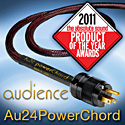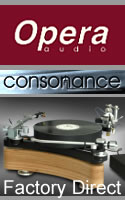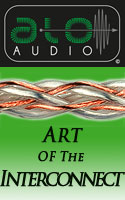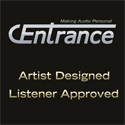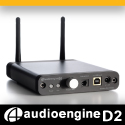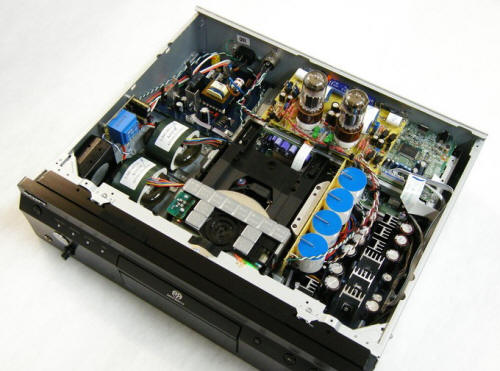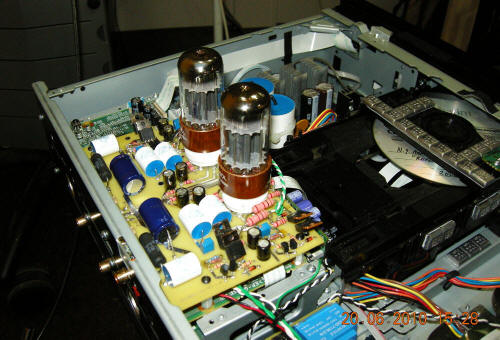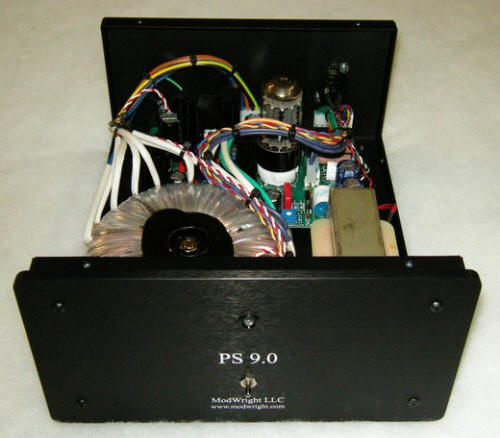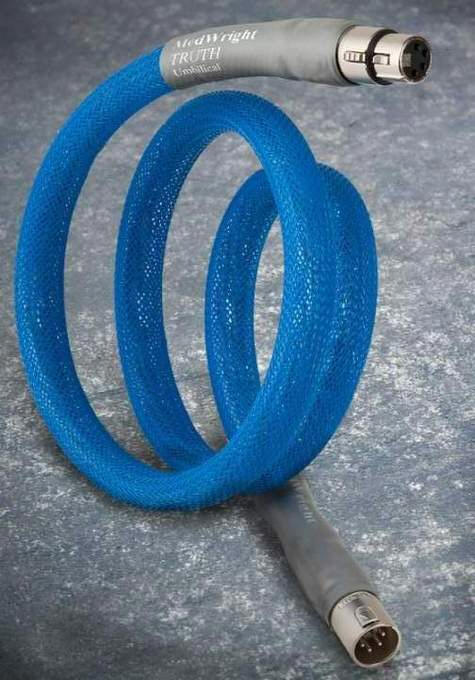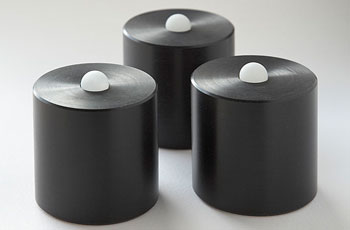|
|
You are reading the older HTML site
Positive Feedback ISSUE 60
modwright Sony SCD XA5400ES Player - The Giant Killer as reviewed by Marshall Nack
One of our shared goals as audiophiles is to discover the hidden gem—the giant killer. Well, I've got one for ya. What follows is little David's tale and, in a way, also a tale of High-End heresy. Please don't ostracize me for it. Periodically, I find entertainment in re-visiting the analog/digital face-off, i. e. comparing a XRCD or SACD of a well-known master tape to an original or audiophile-grade LP of the same. Usually, it involves my $23K MBL Noble digital separates and whatever analog front-end I have in at the time. In these contests, results almost always conformed to expectation—analog ruled. This time around, the analog front-end is a considerably enhanced Goliath: the Dr. Feickert Blackbird turntable with a Shelter Harmony cartridge and the Sonus Veritas Venice phono stage. The lonesome digital component in the other corner was an unprecedented item: little David was represented by the Sony SCD-XA-5400ES, the last SACD player Sony made, a component that can be had on Audiogon for around $1000. (Sony has now abandoned support of SACD. The SCD-XA-5400ES MSRP was originally $2000.)
Stock Sony The software on both was the famous Golden Era recording Daphnis & Chloe (RCA LSC-1893), a Classic Records heavyweight LP reissue and a SACD that BMG-RCA put out in 2004 (82876-61388-2 RE). I would consider them roughly equivalent audiophile editions from the same master tape. Which one played back better? I repeated the face-off for multiple audiences. True, the two don't sound the same, but in the end the jury was hung. That low-end Sony held its ground. The Unmodified Sony on SACD Perhaps I should tell you what it isn't. Prior experience with the first Sony SACD players, the ES-1 and ES-777, left such a saccharine aftertaste that I avoided the format. These machines were tubby in the bass, overly smooth, and warm, obviously compensating for the perceived ills of the medium, as we understood them at the time. They offered few rewards and much to complain about, clearly another instance of the PR machine at work and the consumer in denial. Over time, other manufacturers jumped on the bandwagon and SACD playback improved. Still, I preferred Red Book via my MBL Noble front-end. The Sony 5400 has none of those artificially sweetened characteristics. What it does have is remarkably little evidence of artifacts or technical issues—I'm sure it measures excellently. Its dynamic range is beyond what Red Book (or analog) is capable of—you hear that instantly with the Sony. And it is fast, fast, fast. But most astonishingly, the stock Sony on SACD allows me to suspend disbelief. I have attended live, acoustic performances that sound similar. It is one of a handful of digital components with credible timbre, particularly on woodwinds. And, to top it off, it somehow manages a flowing, musical line, avoiding the blunt, staccato aspect of most digital. It is a real eye-opener. I have speculated about this before, but I think it's worth repeating. The major issue with digital sources (maybe digital anywhere in the loop, not just in the source) is deeply rooted in its very nature: the On-Off paradigm. It starts and stops—it doesn't sound continuous. There is no modulation. The DSD format used by SACD recording has many times more slices of information than Red Book and reduces the gaps. For that matter, I recently heard a demo of a master tape recorded in double DSD. Once again, the proximity to analog was breeched, as those gaps became even smaller. Do you know what's the most continuous device in all audio? Those glass-encased filaments. When compared to analog, half my visitors thought the Sony on SACD on par—not better, but as good. I also compared it to my reference digital front-end: it upped the ante. Note: this comparison was between the Sony's SACD playback and my MBL playing the hybrid layer, since MBL digital doesn't support SACD. This is the Sony at its best: it fulfills the promises of the enhanced SACD format. (For the record, MBL, like Sony, has abandoned the format. They stopped producing their model 1622 Reference SACD transport in February 2011. Now, wouldn't you know it, the 1622 fetches collector-level prices on the used market.) But it is not perfect: strings are a little dry with reduced patina, and there could be more warmth, liquidity and body. Stock Sony on Red Book Alas, I wish I could be more positive, but the fact is the stock Sony on Red Book is nothing you'd want to spend time with. Soundstage shrinks up, dynamics compress, and a grey color is pervasive. The only positive is it still avoids artifacts. The ModWright Sony on SACD As I mentioned, on SACD the stock Sony didn't exactly have a wow factor, but it was good enough to put me in a credible acoustic space, already something rare with digital. However, understand that not all halls are created equal. You hear everything in the Sony's virtual concert venue but it is somewhat anemic. My preferred venues, the ones I buy subscriptions to, also have sweet tone and full body. This is where the Signature Truth Tube Mod for the Sony SCD-XA-5400ES Player from ModWright Instruments Inc. places you.
Timbre & Flow A cluster of classic filament attributes is immediately apparent in the MW Sony: Body is maximally fleshed out; tone is saturated and weighty. The MW builds upon the Sony's already good portrayal of timbre. Listening to it reproduce a cello, an instrument that plays predominantly in the low register, you hear a rainbow of overtones reaching all the way up into the treble on each note. At first I considered this influx of bloom a bit much, and then—rather abruptly after clocking 250-300 hours—it clears up. This is for real: A goodly percentage of the tubey excess evaporated at 250 or so hours. What remains is fully developed and tube-like, but not overkill.
At this point, while there are still some minor undesirable filament effects (bass definition slipped; it doesn't sound as fast as the stock Sony on SACD; transients have acquired a rounded edge) still, it joins the short list of digital front-ends I can listen to without fatigue, or griping. Air The MW's depth layering and portrayal of air are off the charts. You will notice each image is round and three-dimensional, occupying its own area of the soundstage in a very palpable manner. The air around and even inside instruments is rendered such that you can hear the air flowing from mouthpiece into the valves and out of the bell of a French horn, for example. Resolution is on par with the stock Sony, but micro dynamics have acquired a delicious tubey inner life. In comparison, others CD player's depth seems flat and truncated. Stage width, on the other hand, is not drawn as well; depending on the source material, it is often narrower and clustered towards the center. Dynamics The MW's macro dynamics are spectacular, expressing real power and range, the equal of my MBL front-end. No doubt this has a lot to do with the beefy outboard power supply. The MW Sony is two-box set. Visually, the player looks the same, with the exception of the MW label on the front and a pair of 6SN7 valves poking out of the top. These are new production Tung-Sol or Electro Harmonix driver tubes, with an expected life of 6000 hours.
Electro Harmonix tubes The second chassis is the PS 9, an outboard power supply with tube rectification. The Sovtek 5AR4 rectifier tube inside should last 12,000 hours. From the MW website: "The power supply is the heart and life of any audio product… Because of this we are serious about power supply design. First off, we provide our own external high-voltage tube-rectified power supply for the new 6SN7 Vacuum tube based balanced analog stage. The supply is housed in an external steel enclosure, tethered by a 5ft umbilical... The supply is tube-rectified (5AR4) and choke current regulated..."
PS 9 Power Supply No doubt the power supply is also responsible for the excellent soundstage control. Images stay put and don't waver. With multiple instruments, dynamics are managed independently—one may quiet down, while others expand, all work separately. The ModWright Sony on Red Book Another surprise awaited: A goodly percentage of the positives I'm describing carry over to the MWs Red Book performance. It may not have the stage width or the control of the MBL but, even on Red Book, the MW has more of what I consider important, like timbre and musical flow, and ups the ante. It left me shaking my head in joyous disbelief. The MW sounds bold and dramatic—it is not a wallflower. Build Quality and Cosmetics When someone says "modified" regarding a product, my inclination is to back off and look askance. To my mind, it usually means sub-par workmanship, as in irregular, blemished or ill-fitting parts. Cosmetic appeal is not what comes to mind. Not to mention possibly compromised sonics. Happily, the MW is the exception. The finished unit's appearance is such that you would not know it has been tinkered with. The PS 9, on the other hand, does have that utilitarian, black box look. Note: you will need two power cords: one for the Sony chassis and one for the PS 9. The MW enjoyed K-S Elation! cables—power cords, balanced or S-E interconnects—and sat on a Vibraplane ELpF active platform on my TAOC rack. I plugged it straight into the wall—no need for power conditioning. How to get the Most from your ModWright Sony Accessories and Upgrades MW offers several upgrades at additional cost... 1. Truth Umbilical power cord to connect the PS 9 and the main chassis. Retail price is $300 for a 4ft. length. If ordered with the modifications, $250. My sample came with this included.
2. Audio Magic Pulse Gen VX. An add-on to cancel switch-mode power supply noise: $400. 3. Bybee Rails. An add-on to clean up the DC voltage on the power rail to the DAC: $225. I haven't been involved with tube rolling or third party footers in a long time—the MW Sony is ripe for both. First, replace the stock Electro-Harmonix 6SN7s with a pair of Sophia Electric valves from Galen Carol Audio, as MW advises. These new production 6SN7s from China look beautiful and will run you $100 a pop. They cleared up more of the remaining filament excess by tightening the bass, improving focus and controlling the treble.
I found an NOS Mullard replacement for the rectifier tube for $135 at Brent Jessee Recording and Supply. I should have known better: Mullards have a reputation for sounding beautiful, but colored, and so it was with this UK made, short bottle, 7-notch, copper-lined plates 5AR4. You can ask their advice for a more appropriate fit for this application. (FYI: Both tube suppliers were happy to consult over the phone and both provided prompt delivery of quality products.) Footers are also worthwhile experimenting with under the PS 9 or the main chassis. A set of Still Point Ultra SS between the Sony and the ELpF platform enhanced focus and brought dramatic clarity to the point where high intensity spotlights illuminated soundstage images. There was similar spectacular soundstaging when I used TAOC footers. Shun Mook Ultra Diamond Resonators brought back all the tubey bloom and beauty—not exactly what this product needed.
edenSound TerraStones The best of this bunch were footers from edenSound. I started with three half-sized TerraStones under the Sony chassis. (I didn't care for them under the PS9.) Images became more solid without changing size and borders gained definition. The soundstage focused and grew larger. However, there was some loss in speed. These are iso-polymer footers with an antistatic bearing and you use them point side up.
edenSound TerraCones The ultimate footer was a custom number Dan Sherbrook, the proprietor of edenSound, made up to replace the SONYs built-in screw-in feet. This was a TerraCone, again using iso-polymer material but the bearing is replaced with a brass cone and optional receiving base, and it now points down. The top has a screw so the feet can be threaded into the bottom of the chassis. It's all first-rate machine work. The custom TerraCone does everything the TerraStones do, plus texture appeared on the transient and speed was restored, lending the music engaging, foot-taping propulsion. (MSRP for this custom set of four is $380.) Late breaking news: Dan just sent me a trio of TerraStones with brass bearings instead of the Torlon ones he originally supplied. They work beautifully under the PS 9. Now it seems like every SACD I put on is of demo quality. (The new feet are called TerraStone Rollers and feature replaceable bearings. MSRP $165/set of three.) Conclusion Now, at the end of the line, after Sony has stopped supporting the format, an industry insider persuaded me to audition a SCD-XA-5400ES, their last SACD player. I was initially resistant: SACD players have never rocked my boat. In addition, the Sony was way out of my usual component price class. He brought it over on a Tuesday and we listened that night. I went online Wednesday morning and bought a used one for $1,000. The stock Sony on SACD was an eye opener, good enough to compete with quality analog. On Red Book, however, it was sub-par. Some quick online research brought several mod-houses to my attention. Reading the reviews, I decided to go for the full ModWright upgrade and kept my fingers crossed. It didn't disappoint. On the contrary, the ModWright Signature Truth Mod took the Sony (and digital) to the level of the mega-buck front-ends—I kid you not. This is a staggering value: for $3000 you can get a reference-class digital front-end that may be the last you'll buy. Better go and scarf one up now, while they're still available. Marshall Nack
Signature Truth Tube Mod
for Sony SCD-XA-5400ES Player
ModWright Instruments Inc
|
